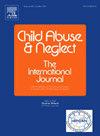青少年不良童年经历、愤怒与暴力:网络分析
IF 3.4
2区 心理学
Q1 FAMILY STUDIES
引用次数: 0
摘要
童年不良经历(ace)是一个复杂的结构,可以看作是一个相互关联的逆境网络,其中一些相互作用明显强于其他的。然而,对涉义青少年逆境之间复杂的相互作用了解相对较少。此外,人们对早期不良经历导致暴力犯罪的途径所知甚少。目的本研究旨在确定逆境网络结构中影响最大的不良事件。它还调查了ace导致暴力犯罪的途径之一。研究对象和环境我们使用了美国德克萨斯州一个大型城市青少年缓刑部门的4591份JIY档案数据。方法采用网络分析方法,研究了10种逆境的网络结构,以及逆境的复杂相互作用如何通过愤怒途径促进暴力犯罪。结果网络分析结果显示,在ace网络中,身体虐待和身体忽视是影响最大的逆境。愤怒与除父母分居/离婚外的所有逆境都直接呈正相关,控制了网络中的其他逆境。在一年的随访中,只有情绪虐待和愤怒直接预测了更高的暴力犯罪可能性,说明了模型中其他逆境的影响。鉴于现有循证干预措施的复杂性,加上少年司法系统资源有限,针对身体虐待和身体忽视量身定制这些干预措施可以在不显著影响JIY有效性的情况下提高可行性。愤怒对暴力犯罪的有害影响突出表明,需要采取干预措施,不仅要解决更广泛的环境风险系统,还要解决个人层面的犯罪需求。本文章由计算机程序翻译,如有差异,请以英文原文为准。
Adverse childhood experiences, anger, and violence among justice-involved youth: A network analysis
Background
Adverse childhood experiences (ACEs) are a complex construct that can be viewed as a network of interconnected adversities, with some interactions being substantially stronger than others. However, relatively little is known about the complex interactions between adversities in justice-involved youth (JIY). Moreover, even less is known about the pathways through which early adverse experiences contribute to violent offending.
Objective
The present study aimed to identify the most influential adverse event(s) within a network structure of adversity. It also investigated one of the pathways through which ACEs contributed to violent offending.
Participants and setting
We used archival data consisting of 4591 JIY in a large urban juvenile probation department in Texas, United States.
Methods
We employed network analysis to investigate the network structure of ten types of adversity and how the complex interactions of adversity contributed to violent offending through the pathway of anger.
Results
The network analysis results revealed that physical abuse and physical neglect were the most influential adversities within the ACEs network. Anger was positively and directly linked to all adversities except parental separation/divorce, controlling for other adversities in the network. Only emotional abuse and anger directly predicted the higher likelihood of violent offending within the one-year follow-up, accounting for the effects of other adversities in the model.
Conclusion
Given the complexity of existing evidence-based interventions, combined with the limited resources in the juvenile justice system, tailoring these interventions specifically related to physical abuse and physical neglect could enhance feasibility without significantly compromising effectiveness for JIY. The deleterious impact of anger on violent offending highlights the need for interventions that address not only the broader system of environmental risks but also person-level criminogenic needs.
求助全文
通过发布文献求助,成功后即可免费获取论文全文。
去求助
来源期刊

Child Abuse & Neglect
Multiple-
CiteScore
7.40
自引率
10.40%
发文量
397
期刊介绍:
Official Publication of the International Society for Prevention of Child Abuse and Neglect. Child Abuse & Neglect The International Journal, provides an international, multidisciplinary forum on all aspects of child abuse and neglect, with special emphasis on prevention and treatment; the scope extends further to all those aspects of life which either favor or hinder child development. While contributions will primarily be from the fields of psychology, psychiatry, social work, medicine, nursing, law enforcement, legislature, education, and anthropology, the Journal encourages the concerned lay individual and child-oriented advocate organizations to contribute.
 求助内容:
求助内容: 应助结果提醒方式:
应助结果提醒方式:


